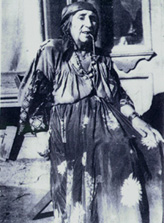

"Gypsies" in the United States 
The Rom
 The Rom arrived in the United
States from Serbia, Russia and Austria-Hungary beginning in the 1880's,
part of the larger wave of immigration from southern and eastern Europe
in the late 19th and early 20th centuries. Primary immigration ended, for
the most part, in 1914, with the beginning of the First World War and subsequent
tightening of immigration restrictions (Salo and Salo 1986). Many people
in this group specialized in coppersmith work,
mainly the repair and retinning of industrial equipment used in bakeries,
laundries, confectioneries, and other businesses. The Rom, too, developed
the fortune-telling business in urban areas.
The Rom arrived in the United
States from Serbia, Russia and Austria-Hungary beginning in the 1880's,
part of the larger wave of immigration from southern and eastern Europe
in the late 19th and early 20th centuries. Primary immigration ended, for
the most part, in 1914, with the beginning of the First World War and subsequent
tightening of immigration restrictions (Salo and Salo 1986). Many people
in this group specialized in coppersmith work,
mainly the repair and retinning of industrial equipment used in bakeries,
laundries, confectioneries, and other businesses. The Rom, too, developed
the fortune-telling business in urban areas.
Two subgroups of the Rom, the Kalderash ("coppersmith")
and Machwaya ("natives of Machva," a county in Serbia) appear
in the photographs in Carlos de Wendler-Funaro's Collection.
De Wendler-Funaro identified some, but not all, Kalderash as "Russian
Gypsies." Another group he identified as "Russian Gypsies"
seem to be the Rusniakuria ("Ruthenians"), who in New York are
known as musicians and singers.
New York City, Woman of the Rom Group, c. 1940
Carlos de Wendler-Funaro Collection, Smithsonian Institution
National Museum of American History Archives Center